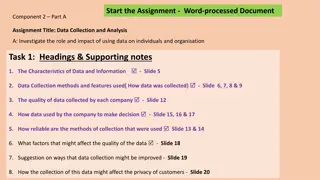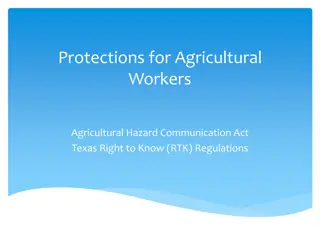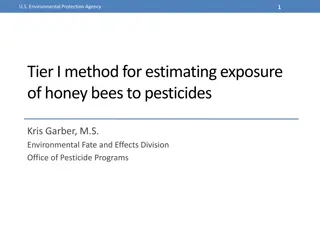Understanding Pesticide Data Collection and Analysis
Pesticide data usage is crucial for accurate assessments and prioritization of areas with high likelihood of usage. Various sources, quality requirements, and data considerations are highlighted, emphasizing the importance of incorporating usage data for informed decision-making.
Download Presentation

Please find below an Image/Link to download the presentation.
The content on the website is provided AS IS for your information and personal use only. It may not be sold, licensed, or shared on other websites without obtaining consent from the author. Download presentation by click this link. If you encounter any issues during the download, it is possible that the publisher has removed the file from their server.
E N D
Presentation Transcript
An Overview of Pesticide Usage An Overview of Pesticide Usage Data Sources used by US EPA/OPP Data Sources used by US EPA/OPP Mark Suarez Office of Pesticide Programs, Biological and Economic Analysis Division October 16, 2019 1
What are Usage Data and Why Incorporate What are Usage Data and Why Incorporate Them? Them? What are Usage Data? Use Where a pesticide may legally be applied Usage Observed agricultural and non-agricultural pesticide applications Number of acres treated or the percent of crop acres grown that are treated Why Incorporate Usage Data? Usage data can: Result in more accurate assessments Differentiate between allowed uses and actual usage Reflect observed agricultural and non-agricultural practices Allow for prioritization of areas with highest likelihood of usage 2
Usage Data Considered Usage Data Considered Identified and reviewed available data: National Data Regional Data State Level Data County/Municipal Level Data Grower/Trade Organization Data Applied pertinent Statutes, Regulations, Policies, and Quality Management Plans governing data quality used in assessments 3
Data Quality Requirements Data Quality Requirements EPA Quality System Policy (CIO 2106.0) Specifies that data are of the type and quality needed and expected for the intended use Standard is to use the best available data Documented quality assurance procedures Statistical methodologies Survey design Credibility, Comparability, Relevance, Completeness 4
Data Sources Data Sources Primary Sources Public US Department of Agriculture (USDA) National Agricultural Statistics Service (NASS) Census of Agriculture Agricultural Chemical Use Program & Agricultural Resource Management Survey CA Department of Pesticide Registration (CADPR) Proprietary Agricultural Market Research Data (AMRD) Non-Agricultural Market Research Data (NMRD) Other sources Other Federal Agencies e.g., Forest Service, Animal and Plant Health Inspection Service A few other States Some crop/pest control associations e.g., American Mosquito Control Association Sales data 5
Quality Requirements Quality Requirements Public Sources USDA NASS https://www.nass.usda.gov/Publications/Methodology_and_Data_Quality/index.php CADPR www.cdpr.ca.gov/docs/pur/purmain.htm Proprietary Sources (AMRD, NMRD) Quality Management Plans Statement of Data Quality 6
USDA Census of Agriculture USDA Census of Agriculture Scope: Complete count of U.S. ag operations Operations that produce >$1000 of commodity in a survey year Conducted every five years For each operation What crops are produced Where crops are produced How much is produced (acres grown and amount harvested) Some information about production practices Reporting: National, state, county level reporting Key Attributes: Authoritative source of crop production info in the US Uniform, comprehensive, impartial 7
USDA Agricultural Chemical Use Program USDA Agricultural Chemical Use Program Scope: 90 Use Sites 731 Active Ingredients 42 States Program state selection: Top-producing states Ensure 80% coverage of target commodity acreage Reporting: Approx. every other year (depending on study) Program state level reporting Aggregated across all program states National approximation Key Attributes: Used as a standard to help validate data from other sources Crops only surveyed by NASS on the national level e.g., blueberries, eggplant, honeydew, oats, and specific caneberries (blackberries and raspberries) 8
Agricultural Market Research Data Survey Agricultural Market Research Data Survey (AMRD) (AMRD) Scope: 60 unique crops 45 states 389 Active Ingredients State selection: Top-producing states Target approx. 95% coverage of row crop acreage, and 80% coverage of specialty crop acreage Reporting: Surveys conducted and published annually State level reporting Aggregated across all surveyed states National approximation Key Attributes: Our most complete data set Majority of agricultural production Highest acreage states for each crop Only source for pest specific information 9
California Dept. of Pesticide Regulation California Dept. of Pesticide Regulation (CDPR) (CDPR) Scope: Complete reporting: All agricultural and professional applicators All use sites treated All Active Ingredients used Reporting: Reported to DPR system continually Published annually State, county, operation level reporting Key Attributes: The full use reporting program comprehensive state usage data Many crops grown almost exclusively in CA comprehensive crop usage data Includes data on very small acreage crops Can be only source of info for these crops (e.g., Napa Cabbage, Bok Choy, Daikon, etc.) Used as a standard to help validate data from other sources 10
Non Non- -Agricultural Market Research Data Surveys Agricultural Market Research Data Surveys (NMRD) (NMRD) Scope: Non-ag market sector information Combo of structured survey and unstructured expert interviews e.g., consumer, turf, pro. pest management, vegetation management, mosquito control, etc. Location selection: Sampling frame influenced by market size and share information Reporting Conducted approx. every other year National level Regional usage available for some studies Key Attributes: Our only source of non-agricultural chemical usage data Narrative descriptions of data Studies go back many years 11
Limitations of Available Usage Data Limitations of Available Usage Data (and data gaps) (and data gaps) There are no perfect data Not all crops are covered (e.g., some minor crops, sugarcane) Not all states are covered (e.g., small market states like Alaska, Hawaii and Vermont) Not all data are available/usable at fine scales State level is the finest usable scale available for most ag crops. Regional data are generally all that are available for non-ag sites. These limitations do not affect the quality of the data that we do have. The majority of uses are included in one or more of our usage sources. We can use available data to extrapolate and fill data gaps across sources. 12























